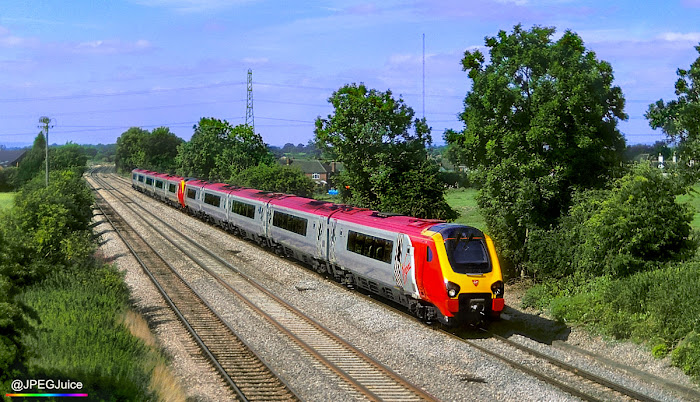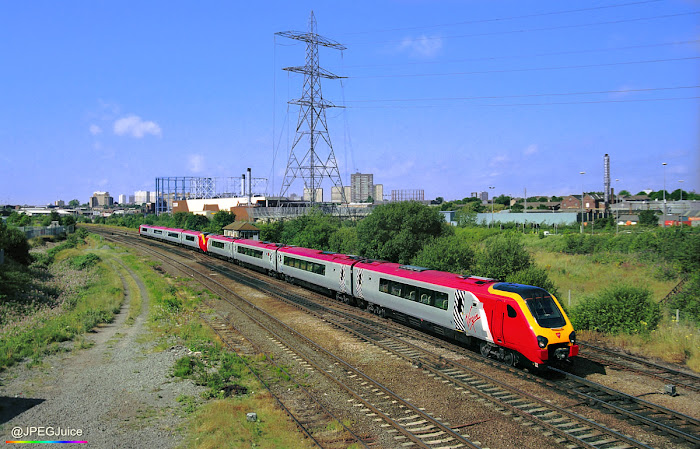"The first UK sighting of the Voyager’s now familiar front end came on 6th July 2000... Five months later to the day, a high-profile and ceremonious outing for 220001 set out to woo the press."

220003 imposes at Birmingham New Street in the year of introduction - 2001. Class 47, No. 47793, is representative of the outgoing stock.
Back in the mists of March 1998, an eyecatching edition of RAIL magazine appeared on the newsagents’ shelves. The cover featured two artist impressions of futuristic-looking trains, and a headline alluding to a £1.85bn order for new Virgin passenger stock. The larger of the two images documented what was believed, at the time, to be the external design of the Bombardier DEMU which would serve the CrossCountry network. The DEMU was not, at that point, described as a ‘Voyager’, it did not look like a Voyager, and Virgin had a different plan for CrossCountry from the one that eventually came to fruition.
When Virgin announced these plans on 3rd March ’98, its intention was to take only 43 of the DEMUs which would ultimately finalise into the form of the Voyager. All would be four-car formations, and all would tilt. The rest of the new CrossCountry trains – totalling 34 more sets – would comprise unpowered rolling stock with a single-cab Class 67 at one end and a DVT at the other. Notably, although the DEMUs would be equipped to work in multiple formations, Virgin did not foresee operating them in pairs at that stage; presumably because the 34 loco-powered formations would cater for higher passenger volumes.
THE DEAL IS SEALED

220022, as new and on a training run at Kings Norton in 2001.
But by Friday 4th December 1998, when Virgin Trains sealed the deal, the order had evolved. The requirement was now for 34 non-tiling four-car Voyagers (Class 220), 4 tilting four-car Voyagers (Class 221), and 40 tilting five-car Voyagers (Class 221). The cost had evolved too. Of the £1.85bn quoted the previous March, £858m had been assigned to the CrossCountry trains. The rest was for the West Coast electric renewal. By December, the cost of the CrossCountry renewal had risen from £858m to £1.06bn. The greater proportion of these costs related not to the trains themselves, but to the accompanying, far-reaching maintenance contract.
The task of completing the Voyager order would be shared between the Bombardier plants in Brugge and Wakefield. The Voyagers would have a top speed of 125mph, and a power unit per vehicle giving each train excellent power to weight and impressive acceleration. In terms of both performance and reliability, Classes 220 and 221 promised CrossCountry a serious upgrade.

So, nearly two years after Virgin had taken over a chaotically unreliable CrossCountry network from British Rail, a monumental renewal programme was finally in motion. The Voyager was coming in as the sole replacement for CrossCountry’s ailing, failing, British Rail remnants. It was now just a matter of time.
‘Voyager’, incidentally, was quite a predictable name for the new trains. Not only had Maiden Voyager been the name of the Boeing 747 which launched Virgin Atlantic in 1984, it was also the name of the HST power car which launched Virgin Trains in 1997. The name Maiden Voyager would subsequently be transferred to Class 220 No. 220001, when it took part in a pre-service trial run for the press in December 2000.
PRE-VOYAGER

Deltic D9000 in its days with Virgin Trains.
CrossCountry in the late 1990s had been a goldmine for fans of first-generation loco-haulage. A late ’90s summer Saturday would see nearly 60 loco-hauled trains across VXC alone. The rest of the CrossCountry timetable was covered by a fleet of 24 Paxman Valenta-engined HST sets, and a handful of 158 units.
In fact, the composition of traffic was not significantly different at the dawn of the new century, from the way it had been in the late 1980s, and the core Class 47/8 locomotives had been old even then. In 1997 – Virgin’s first year in the CrossCountry hotseat – failure rates were truly embarrassing. Rail enthusiasts had the time of their lives, as the cream of esoteric traction was roped in to address the chronic availability problems. Diesel fanatics will never forget the return of Deltic-hauled service trains. But for those trying to run a modern, professional passenger network, the CrossCountry of 1997 to 2001 must have been agony.
THE CLASS 220 APPEARS
The first UK sighting of the Voyager’s now familiar front end came on 6th July 2000, when a bogieless driver car, manufactured at the Brugge plant in Belgium, travelled via ferry to Immingham, and then by road to Bombardier Wakefield for the second stage of its fitting out.
Five months later to the day, a high-profile and ceremonious outing for 220001, between Brugge and Ostend, set out to woo the press. Initial reactions were very positive, and it was revealed before the start of UK services that drivers were also impressed by the Voyagers. While initial UK testing took place on the Monk Bretton branch, the high speed trials were run on the ECML. Tests were successful and there was no delay to the intended introduction of Class 220 units on revenue-earning services. The target for introduction was the start of the summer timetable in May 2001, and that’s exactly when it happened.

The Class 220s originally had red Virgin badge plates on the cab front. These were changed to silver badges after the Class 221s went into service carrying red badges. This double set, typical of the pre-Operation Princess phase, is led by 220025.
On 21st May 2001, 220001 had the honour of introducing regular passengers to Voyager travel, when it worked an additional 09:21 Birmingham to Reading and 11:44 return service. Only two Voyagers had been accepted into traffic by this date – the other being 220016. The Birmingham to Reading route soon established two regular Voyager diagrams, neither of which were part of the published timetable. The first timetabled use of Voyagers began in late July, on the Birmingham to Brighton route.
Through to the end of summer 2001, most CrossCountry passengers saw little if anything of the Voyagers. There still weren’t many units in service, and even by mid autumn when over 20 Class 220s had been accepted into traffic, it was possible to spend long periods at significant CrossCountry stations and not see one. Service trains began to employ pairs of Voyagers, which cut the number available, and some of the available 220s were allocated for training purposes, which cut availability even further.
The core of the traffic in November was still very much a picture of HSTs and locomotives. But later autumn saw the Class 220s gaining a higher profile. By the end of 2001, the Saturday timetable had 35 loco-hauled CrossCountry trains remaining.
CLASS 221 HITS THE SCENE

When I photographed 221112 at Bescot Stadium on 4th April 2002, it was not yet in passenger service, and its seats still had the manufacturer’s plastic covers over them. Note also that it only has four of its five cars. Because of the way they were produced, the 221s were delivered either in this format, or as 6-car sets, then re-packaged into the correct 5-car format at their operational headquarters - Central Rivers. The re-composition was not necessarily immediate, and 4-car 221s from the 5-car series could commonly be seen in service through the summer of 2002.
There was more ceremony surrounding the delivery of the first Class 221. Virgin CEO Chris Green was presented with both the final Class 220 and the first 221, at Bombardier Wakefield, on 13th December 2001.
Whilst the first 221 was technically handed to Virgin in late 2001, this was really a publicity measure, and it would be well into 2002 before any Super Voyager passenger service began. And although the first tilting journey for a Class 221 ran in France on 1st February 2002 for invited guests, when UK service started, the tilting mechanism was initially disengaged.

Operation Princess saw the previously typical double Voyager sets split into individual units, but they still doubled up for trains with high passenger volume - particularly in the summer. Here's a ten-coach consist comprising two 5-car 221s.
UK passenger service for the 221s commenced on 12th April 2002. Because there was already a fleet of 221s basically ready to go into traffic by this time, and at least one new delivery per week ongoing, the remaining loco-hauled service sharply waned. The official finale for CrossCountry loco-haulage came over the weekend of Friday 16th to Monday 19th August, with ‘last trains’ spread across that period. But even before that, there was barely anything left.
OPERATION PRINCESS
The massively ambitious Operation Princess timetable, commencing on the last day of September 2002, was the point at which the Voyagers established real dominance of the CrossCountry network, and it can be considered pretty much the end of the introduction phase. It saw the Voyagers finally cease working in doubled up formations, as had been routine for them since autumn 2001. Not quite all of the fleet were yet in traffic, and Virgin had even retained a trio of 158s as well as some HST cover, but for the enthusiast at the lineside, the transformation was startling.
What had, just six months earlier, still basically been a British Rail-style CrossCountry with a minority of the services switched over to Class 220 travel, was now a total blitz of Virgin Voyagers, with no scheduled loco-haulage, and just six diagrams left for reconstituted HSTs. The train of the future, was now the train of the present.

A final memory of the early days. Doubled-up Class 220s at Washwood Heath.
You can now find much more detail on the early days of Voyager service, info on early namings, when they took over various routes, etc, in The Timeline of Transition.